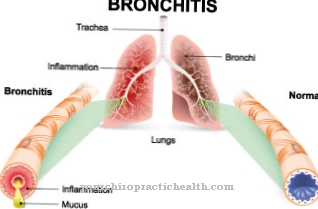The Farmer's Lung occurs mainly in people who deal with plant residues at work. These include, for example, hay, straw and dry fodder. If left untreated, it can become chronic and cause death.
What is a farmer's lung?

© blueringmedia - stock.adobe.com
The farmer's lung is an inflammation of the alveoli caused by bacteria and mold spores (exogenously allergic Alveolitis). The immune defense identifies the inhaled ("exogenous") spores and their components (allergens) as foreign.
The triggered allergic reaction is an "excessive response" of the organism. The result is inflammation of the alveoli, which can be acute or chronic. A chronic inflammation of the alveoli may turn into what is known as pulmonary fibrosis:
Due to the increased formation of connective tissue, the elasticity of the lungs and thus breathing is impaired. Due to the connective tissue, the lungs are also less and less able to supply the blood with sufficient oxygen. The resulting decrease in the oxygen content is expressed in a lower physical and mental resilience. As the lung fibrosis progresses, shortness of breath occurs even at rest.
causes
The storage of plant residues can lead to a strong increase in bacteria and mold. This process is promoted by warm and humid conditions. For example, if the weather is mild and rainy after the grass has been mowed, mold deposits form inside the stored hay after a short time. When moving the crop again, the fungal spores easily get into the air and can be inhaled.
The spread of fungal and bacterial spores is also possible during the grain harvest, when distributing the litter in stables and during the production of feed in the silo. Other sources are the moving of compost heaps and the extraction and storage of wood chips. Their small size allows the spores to penetrate the alveoli and provoke inflammatory processes.
Symptoms, ailments & signs
The acute form of the farmer's lung usually manifests itself in cough, shortness of breath, chills and fever. Tightness in the chest, runny nose and a general feeling of weakness are also described. The fever with temperatures up to 40 ° C can occur like attacks. Some patients complain of brown-yellow sputum and a burning sensation in the throat.
Pale red, foamy blood is more rarely coughed up. These symptoms appear just a few hours after contact with the inflammatory spores. They usually subside again overnight, only to reappear when the allergens are next exposed. In some affected persons, however, this symptom, which is sometimes described as flu-like, is less noticeable (subacute).
It is observed, for example, in people whose organism is less sensitive to the fungal and bacterial spores. Others are only exposed to low levels of spores, so that the symptoms are correspondingly weaker or even unspecific. Symptoms such as loss of appetite, insomnia and throat irritation can be the expression of many diseases.
If the spores act regularly over many years, the inflammatory processes triggered by them express themselves in a further deterioration in the general condition and in weight loss. It is an indication of the progressive formation of connective tissue in the lungs (pulmonary fibrosis) and thus of the transition of the farmer's lung into the chronic phase.
diagnosis
The blood of sick people shows a significant increase in white blood cells (leukocytosis). T lymphocytes are increasingly found in the lungs, which is an expression of the inflammatory process taking place there. As so-called killer cells, they serve to recognize foreign substances that have entered and to eliminate them. An important symptom of a farmer's lung is the presence of so-called immunoglobulin G (IgG) antibodies in the blood.
These are also formed when viruses, bacteria or foreign substances have entered the organism. In the pulmonary function test, a reduction in the extensibility of the lungs and chest indicates restrictive ventilation disorder. It is explained by the increasing formation of connective tissue between the alveoli and the scarring of the alveoli walls.
An acute farmer's lung manifests itself in the X-ray image as a collection of fine spots. The reduction in the diffusion capacity of the lungs indicates that less oxygen can be taken up by the organ and released into the blood. Computed tomography of the lungs (chest CT) and bronchoscopy (lung specimen) are also used. Between 1 and 17% of patients die as a result of farmer's lung disease. The stress on the cardiovascular system threatens heart failure.
Complications
In the worst case scenario, a farmer's lung can lead to death. However, this only occurs if the farmer's lung is not treated. In most cases, patients have symptoms of a common cold or fever. These include chills and fever.
However, there is severe shortness of breath and coughing, which is associated with a high level of mucus. The flu symptoms also lead to a feeling of weakness. Physical work is hardly possible any more. The fever can reach very high temperatures and become extremely dangerous for the body.
Temperatures of up to 40 degrees Celsius are possible here. In severe cases, coughing up blood occurs, which leads to a panic attack in most people. The farmer's lung also leads to loss of appetite and sleep problems. This can lead to underweight and dehydration. Both conditions are very dangerous for the body and must be avoided.
The farmer's lung usually develops over several years and is manifested by more and more frequent lung problems. Targeted treatment is not possible. However, the symptoms can be prevented if contact with the triggering substances is avoided. The farmer's lung improves by itself over time, but there is no complete regeneration.
When should you go to the doctor?
In the case of a farmer's lung, a doctor must be consulted in any case. This disease must always be treated by a doctor as it does not heal itself. In serious cases, the farmer's lung can also lead to the death of the person concerned. The doctor should be consulted if the patient has a high fever and continues to have chills.
A very strong cough with bloody sputum can also indicate the farmer's lung and should be examined by a doctor. The symptoms are often not permanent, but keep coming back. Insomnia or loss of appetite can also indicate the condition and should be investigated if they occur over a long period of time. An examination should always be carried out, especially in the case of chronic complaints.
The farmer's lung can usually be identified by an internist or a general practitioner. Further treatment is then carried out by taking medication. In order to prevent further complaints, the person affected should always wear respiratory protection. In some serious cases, patients also need psychological treatment.
Doctors & therapists in your area
Treatment & Therapy
There is currently no cure through medication or surgery. The shorter the exposure time to the allergens, the lower the risk of permanent changes in the lung tissue. This so-called allergen avoidance can bring the disease to a standstill.
These can be the immunoglobulins mentioned, for example. Cortisone can be given to relieve inflammation that has already occurred. Representatives of this class of substances promote the formation of white blood cells, which are increasingly formed during inflammatory processes. At the same time, however, they inhibit the release of substances in the body cells that are directed against foreign proteins (i.e. allergens).
The latter get into the human organism via the inhaled fungal and bacterial spores. The immunosuppressive (suppressing the body's own immune system) and antiallergic effects of cortisone play a decisive role in alleviating the symptoms described. The drug has a decongestant effect on the mucous membranes of the airways, relaxes the bronchial muscles and reduces the formation of bronchial mucus.
However, the positive effects sometimes only set in after a time lag of several days. For patients in whom the disease has developed into a chronic stage or into pulmonary fibrosis, therapeutic measures to actively improve respiratory performance are recommended: These include exercise, conditioning and strengthening programs.
A healthy diet and psychotherapeutic treatment are also beneficial. A lung transplant if the pulmonary fibrosis is severe leads to a five-year survival rate of around 50%. It is recommended under certain conditions.
Outlook & forecast
Patients with farmer's lung disease generally have a good prognosis. If the disease is recognized and treated at an early stage, a rapid improvement in the symptoms can be achieved. Cough, shortness of breath and other complaints usually subside as soon as the cause of the disease has been eliminated and drug treatment initiated.
Acute farmer's lung can in some cases lead to heart failure and thereby death of the patient. A chronic disease develops insidiously and also puts a considerable strain on the cardiovascular system. Symptoms such as breathing difficulties and pain increase in intensity over time and permanently impair well-being. In the long term, an untreated, chronic farmer's lung is also fatal.
Coughing up blood and a high fever can trigger a panic attack in those affected and cause emotional problems. The farmer's lung can also cause loss of appetite and sleep problems, which make the general condition even worse.
Nevertheless, the outlook and forecast are generally positive. Provided early therapy is provided, a farmer's lung usually proceeds well and does not cause any further health problems for those affected. Any damage to the lungs that has already occurred must be treated symptomatically.
prevention
Basically, the duration of handling plant residues should be kept as short as possible. Certified breathing masks with protection level P2 also help to keep any dust that may be blown up from the lungs. The particle filter mask FFP2 / 3 is recommended. Standard protective masks are not effective enough. Combine operators should always keep the control cabs closed. Their ventilation may only take place via systems that can keep dust contaminated with spores away.
Before bringing in the hay stored in the meadows, it should be turned several times. This is especially true after damp and mild weather conditions. One possible measure to reduce dust when handling dry food is to mix it with a little vegetable oil.
Aftercare
In the case of a farmer's lung, in most cases there are no options for follow-up care available. The disease cannot be completely treated and in most cases significantly reduces the life expectancy of the person affected. Self-healing does not occur either, so that the farmer's lung can only be treated symptomatically.
The triggers of the disease should be avoided at all costs so as not to put additional strain on the patient's lungs. In many cases, those affected are dependent on the intake of cortisone. However, there are strong side effects that should be treated as well.
When taking it, you should therefore ensure that the dosage is correct and that it is taken regularly in order to prevent further complications. The airways must be relieved so that the person concerned should not smoke either. In order to increase the performance of the lungs again, the patients can perform various exercises, whereby in general a healthy lifestyle with a healthy diet can have a positive effect on the development of the farmer's lung.
In the case of pronounced or severe complaints, those affected are often dependent on the help of their fellow human beings in everyday life. Above all, loving care by one's own family has a positive effect on recovery.
You can do that yourself
Farmer's lung is a dangerous disease that, if left untreated, can be fatal. Those affected should therefore not treat the symptoms themselves, but should consult a doctor promptly.
The best form of self-help is complete allergen avoidance. The disorder usually develops slowly over years and can be stopped in its progression by consistently avoiding the causative substances. Very often the symptoms improve considerably over time, even if a complete regeneration of the damaged lungs cannot be expected.
Often, simple measures can help to reduce stress. Farmers should definitely wear a high quality P2 protective mask when working with hay, straw and other dried grasses. If you handle dry food, you can moisten it slightly or add vegetable oil to prevent excessive dust formation.
However, if it is not possible to avoid allergens, at least in severe cases, a new professional orientation must be considered in good time. Since the farmer's lung is a recognized occupational disease, those affected are relatively well protected socially. Self-employed farmers can get advice from their association, and dependently employed helpers in agriculture from their trade association.



.jpg)





.jpg)



.jpg)



.jpg)







.jpg)


